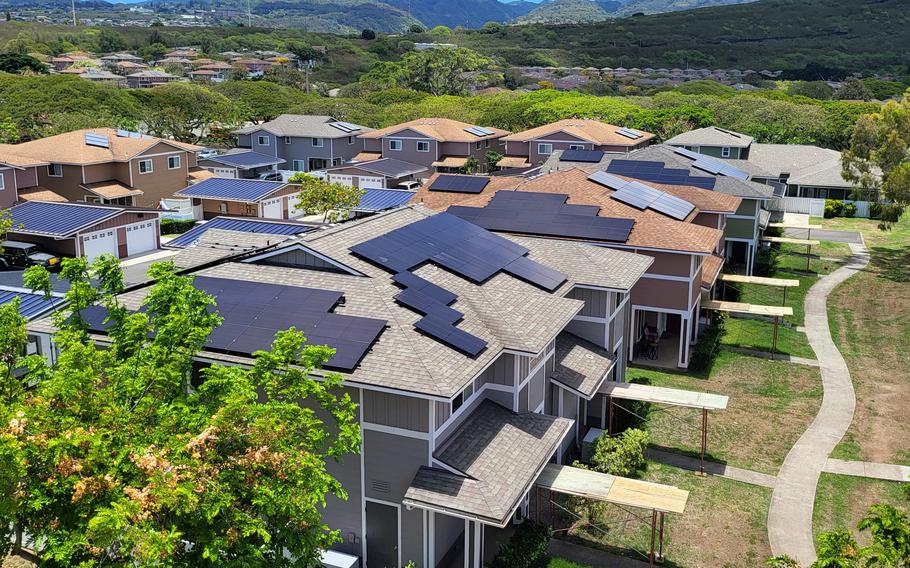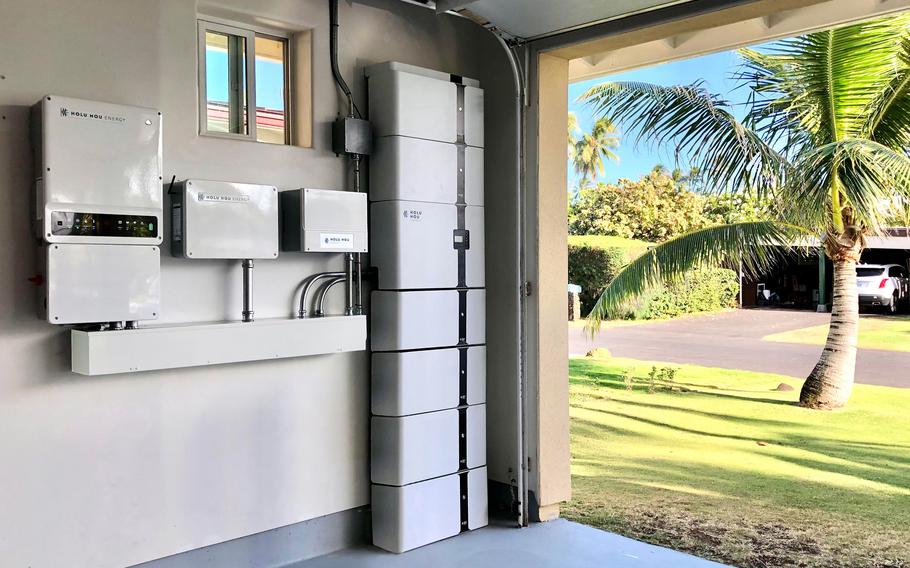
These homes at Aliamanu Military Reservation on Oahu, Hawaii, were part of a pilot program in 2022 to test the concept of solar-clustering four to six homes. (Lendlease Communities)
FORT SHAFTER, Hawaii — The installation of solar panel clusters is expected to begin in July at 200 homes in the Army’s Aliamanu Military Reservation in Honolulu, an energy resiliency project that is planned for thousands of military residences on Oahu.
Lendlease Communities, which operates nearly 8,000 homes on Oahu under a partnership between its subsidiary Island Palm Communities and the U.S. Army, has contracted with Holu Hou Energy, a Delaware-based company, to install photovoltaic and battery systems in four- to six-home clusters on the island.
The panel-battery system within any single cluster is optimally sized so that most of the power generated is used within that group of homes, Brad Hansen, chief executive officer for Holu Hou, said by phone April 14.
Each cluster will use about 75% to 80% of the power generated by its system, he said. Homes remain connected to the grid for shortfalls in the solar supply.
A major investor in Holu Hou, China-based Borqs Technology Inc., is being forced to divest in the company due to national security considerations. Borqs acquired 51% of Holu Hou in October 2021.
Borqs announced in December that the Committee on Foreign Investment in the United States, an inter-agency governmental committee with jurisdiction over foreign acquisitions of U.S. businesses involved with technologies critical to national security, had reviewed the acquisition and required divestiture.
“We never had any products or services or anything from Borqs,” Hansen said. “They were a passive investor, so the unwinding is pretty simple.”

Solar-power hardware was installed in 2022 in this home at the Army’s Aliamanu Military Reservation in Honolulu as part of a solar-clustering pilot project that will now expand to hundreds of homes. (Holu Hou)
First 200 homes
Holu Hou first tested the cluster concept a few years ago at a 134-unit low-income housing development on the island of Kauai, he said. Then, through most of 2022, Holu Hou conducted a pilot project with a cluster of six homes at Aliamanu.
With that successful trial, Lendlease plans to set up clusters throughout all the housing managed by Island Palm Communities on Schofield Barracks, Wheeler Army Air Field, Fort Shafter, Tripler Army Medical Center, Helemano Military Reservation, Red Hill and Aliamanu.
“We can get the maximum benefit sharing at about six units,” Hansen said. “Beyond that, you can add more units if you want, but you've already reached the maximum benefit of the sharing.”
Homes will be clustered primarily based upon their proximity. Trenching will be required to bury electric cables connecting the cluster, but groupings will be arranged to avoid trenching across asphalt as much as possible.
Holu Hou is partnering with at least two large Hawaii-based firms to perform the installations.
Work on the first 200 homes is expected to begin in July and be completed by the end of the year, Hansen said.
Solar ‘sweet spot’
Multi-dwelling unit housing has been a “dead space for the solar industry” until now, Hansen said.
“The most difficult thing to do in solar is put it on multi-dwelling unit properties, especially rental properties, where you've got load uncertainty,” he said. “You can have a high-load tenant or family on one month, and the next month a low load tenant lives in that unit.”
Clustering creates a more stable load.
“You want to get 75 to 80% of the electricity for the residents to be coming from solar,” he said. “That's kind of the magic number. The sharing allows you to do that and be at that sweet spot while not exporting [to the main grid] … because in California or Hawaii you don’t get paid very much for that.”
In 2015, the Hawaii Public Utilities Commission issued a rule that slashed the amount customers could get for exporting surplus solar energy to Hawaiian Electric Co., which supplies most of the state’s electricity.
More stable grid
Hawaii’s electricity prices are roughly three times the U.S. national average, according to the U.S. Energy Information Administration. In September, Hawaiian Electric ended the use of its last coal-fired power plant and forecasted an average increase of 7% for individual electric bills.
The state is working toward transitioning its energy generation to 100% renewable sources by 2045.
“We’re providing backup power to our residents so if there's a power outage, they essentially are not impacted by that,” Matt Lynn, senior vice president of energy and utilities for Lendlease, told Stars and Stripes in January.
“These systems can help to stabilize the electrical grid on the island by lowering demand on the grid to help avoid power outages in the future,” he said.